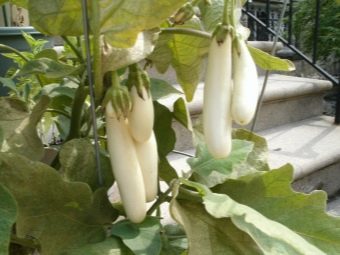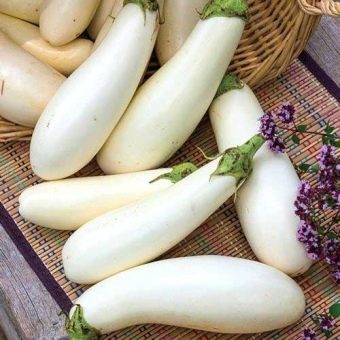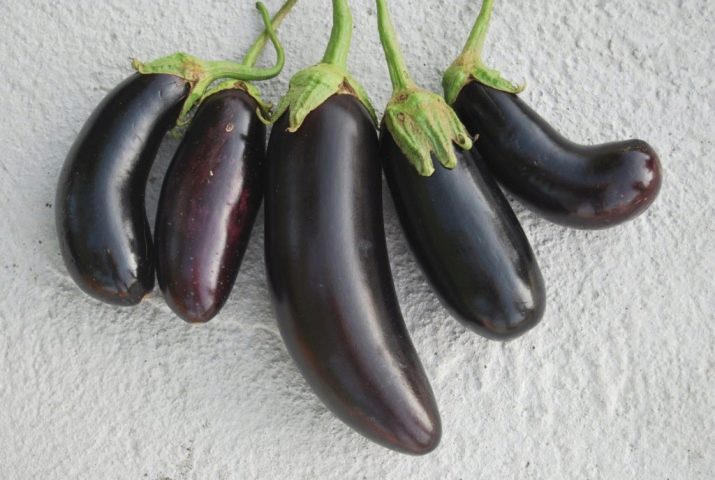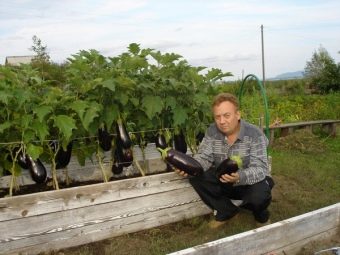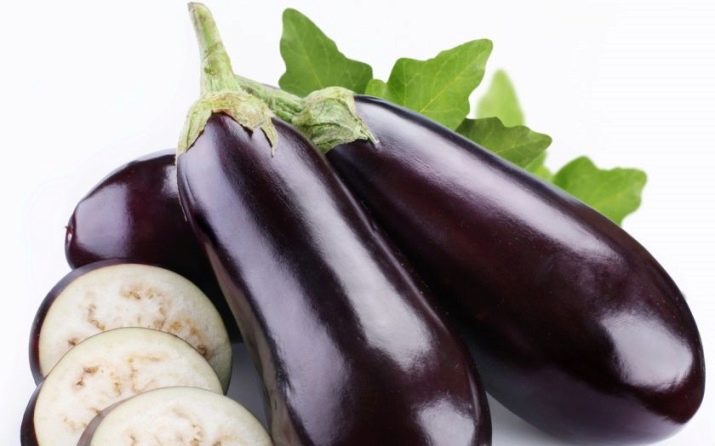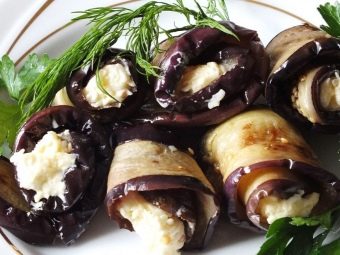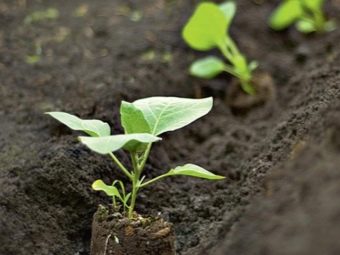The best varieties of eggplant
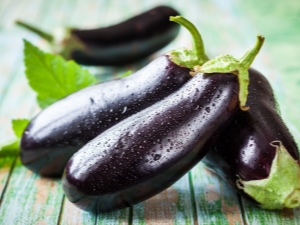
Today there is a huge variety of different hybrid varieties of eggplant. No wonder that they are easy to get confused.
Features of culture
Eggplant is a popular agricultural crop in Russia. More recently, far from everyone could afford it. The thing is that eggplant is thermophilic. Only recently have breeders bred varieties capable of tolerating relatively cold.
Growing and caring for eggplants is quite complicated. Culture loves moisture and light, and without their constant presence, it quickly withers. At the same time, too abundant watering damages the eggplants: the buds fall, and the overall growth slows down.
The quality of the soil is also not in last place. An important element in which eggplant is in increased need is nitrogen. Therefore, it is important to timely feed and ensure that the soil has enough nutrients.
Planting eggplant is carried out first in pots for growing seedlings at home. First they plant seeds, and then seedlings are planted directly in the ground. In this case, the temperature should be high - about +25 degrees. Then the eggplant will develop well and grow.
Kinds
There are many types of eggplants. First of all, they differ in color.
Purple
In Russia, eggplant of violet color is most popular.
As a rule, they are unpretentious in care and better than others are adapted to collecting sunlight, which is so lacking in most regions. Most often, choose two varieties of purple eggplants: "Black Handsome" and "Diamond."
Also noteworthy are such species as "Albatross", "Bourgeois", "Black Moon".
Whites
White eggplants surprise no one. They are firmly entrenched in the suburban areas. This happened not only due to an interesting and unusual appearance, but also excellent taste characteristics.
As a rule, white varieties are hybrids, popular among which are “Taste of mushrooms”, “Pelican”, “Icicle”, “Thai ribbed”. By the way, the fruits of the “Icicle” variety have a white color, and not a milky one, like all the other varieties.
Lilac
Lilac eggplants are different from purple saturation of color.
If in the first case the fruits often have a beautiful pattern, in the second the skin is almost black. Lilac eggplants are quite capricious when cooking, as they have an unusual taste. In Russia, the demand for such varieties as "Lilac", "Balagur", "Pink Flamingo", "Bumbo".
Green
Green eggplant can still be found quite rarely. This is due to the impracticality of the fruits of these varieties.
As a rule, they are small. In addition, it is quite difficult to determine the degree of maturation of the fetus. However, these unusual patterns found their fans. So, in Russia, special varieties of "Emerald", "Green", "Chinese green eggplant" are in demand.
Red
Bright-colored eggplants are still exotic for Russian summer cottages.
It is almost impossible to meet red eggplants grown not for decorative purposes, but for food. Most often they have similarities with tomatoes. Thorny bushes: thorns are placed on the trunk of a plant. Unlike fruits, thorns have a purple color.
Unfortunately, the taste of red eggplants leaves much to be desired. Many who have tried them, note that they are bitter.
Orange
Orange eggplants are grown as a medicinal plant. Extract is obtained from the fruit, which is subsequently used for anticancer drugs.
However, this does not mean that the fruits of the plant are not edible.On the contrary, young eggplants have an amazing smell and taste, but with maturation all these advantages disappear. The flesh begins to taste bitter and to eat it is impossible, so that only young fruits that have not picked up color can be eaten.
Yellow
Yellow eggplants can be found in vegetable gardens in Russia more often. There is even a special variety suitable for domestic realities, which has the saying name “Golden Eggs”.
The fruits of this variety are round or oval. The pulp in taste is not much different from the classic purple or lilac eggplant, but it contains a lot of keratin, which makes the fruit more beneficial to health.
Hybrids
Hybrids are produced by crossing different varieties with each other. The purpose of such breeding works is new properties of plants.
This is how frost-resistant or high-yielding varieties were obtained. Virtually all available eggplant hybrid varieties. There are practically no “clean” representatives, as they often not only require more scrupulous care, but they are also inferior in taste.
Hybrid varieties are labeled with numbers (for example, “Early 148”) or have an alphanumeric designation (“Behemoth F1”).
In shape, eggplants are also distinguished into several types.
- Classic. Classic oblong eggplants are widely distributed. They are convenient for further cutting and preparation of fruits, it is also convenient to fold and store them. Classic eggplants in the form of an elongated ellipse, and the ratio of thickness to length can be different, ranging from 1: 2 and ending 1: 5, as is the case with the brand "Icicle". The form does not have any significant effect on the taste characteristics of the fetus.
- Spherical. Round fruits hung with tall shrubs still look unusual in our realities. Many do not even immediately realize that they face an eggplant. Indeed, spherical eggplants are easily confused with tomatoes or peppers due to their unusual shape and often coloring. Nevertheless, round varieties also found their consumers, because in terms of taste they are not inferior to more conservative representatives.
Which plant?
Deciding on planting a variety can be difficult. Here it is important to pay attention not only to the taste and visual appeal of the fruit, but also to the growing region, the period of time through which the first crop can be harvested, the characteristics of the variety - its “capriciousness” and difficulty in caring.
For example, the same variety that is planted in the Stavropol Territory is hardly suitable for the northern region, and for the Moscow region varieties that have taken root in the Volga region are not suitable.
When choosing, you must rely on the variety description given by professional agronomists or breeders. Now you can easily find any information. Also, do not neglect the advice of amateur gardeners. They more than anyone else know about all the "pitfalls" that may lie in wait for those who want to grow this or that species in their area.
So, the first thing you should pay attention - the term of ripening fruit. The most popular are ultra early or early varieties, of which there are a great many today. You can choose a variety that is suitable for your region.
Early
All eggplants belong to early ripening, the period between the emergence of seedlings and the fruiting of which does not exceed 115-120 days. Obviously, why almost every gardener wants to breed such varieties. The ability to harvest quickly, in theory, having the opportunity to plant eggplants again is a big plus.
There are many different varieties that fit the description of early ripening. It is recommended to pay attention to the options described below.
"King of the North F1"
This variety is relatively young, but it has already managed to gain popularity among gardeners and vegetable growers.The plant turns out low - only 40-50 m in height. Interestingly, breeders have achieved that there are no thorns on the bush. Therefore, you can not be afraid to get hurt, gathering the harvest.
Ripened eggplants are rich purple, smooth and glossy. The shape is ellipsoid, classic. Eggplants are quite large: they can be as long as 40 cm in length. The typical length is 30 cm. The flesh of this hybrid is white and dense.
When cooking eggplant, there is no need to soak it in order to level bitterness, since the fruits do not absolutely taste.
This hybrid is one of the earliest, although the fruits are formed during the entire summer season.
Among other things, the “King of the North F1” is characterized by increased resistance to cold, so it can be grown in areas that are relatively unfavorable for agricultural activity. The most important thing is to pay attention to the quality of the soil. If it does not have enough nutrients, the fruits will not form properly and will not have the stated taste.
"Hippo F1"
Eggplant "Hippopotamus F1" refers to tall varieties. If you plant it in a greenhouse, you can grow a plant up to 2.5 meters in height.
On open ground, the height is significantly less - up to one and a half meters. In general, the process of the formation of fruits takes 3-3.5 months after planting, which allows us to speak about the early ripeness of the variety. The plant is purple in color, the skin is thick, smooth, glossy. The flesh is whitish-yellow, dense.
If you do not soak the fruits beforehand, they will taste bitter, so it will be necessary to carry out preparatory procedures before cooking.
Mature fruits have a mass of about 300 grams, reach 17 cm in length. Eggplants are thick, pear-shaped.
This variety belongs to one of the most high-yielding. With each square meter there is an opportunity to collect more than 17 kg. Keep in mind that the yield depends largely on the climate in which the plant was grown. The disadvantage is that the plant has thorns, so you can get hurt during harvest.
Interesting is the fact that you can not use cold water for watering eggplants variety "Behemoth F1". Also, you can not water the green parts of plants, as this will adversely affect their overall condition. It is best to equip a drip irrigation system. It will save you time and effort, while creating the best conditions for these eggplants.
"Giselle F1"
This early ripe hybrid is in demand mainly from residents of the northern regions. It is well tolerated by the difficult climatic conditions of such areas, as it is resistant to droughts, which are not uncommon here. Even in such difficult conditions in 3.5-4 months after germination can be harvested from shrubs.
This variety refers to high-yielding. Up to 18 kg of crop can be obtained from a square meter when growing a crop in a greenhouse and up to 9 kg when growing on open ground. The height of bushes reaches 120 cm when planted in open areas. Stems practically without thorns.
The fruits are beautiful, smooth, shiny, black and purple. Eggplant "Giselle F1" classic ellipsoid, large. The weight of each fruit can reach half a kilogram, and length - up to 30 cm. The advantage is that eggplants can be stored for quite a long time: they do not deteriorate for a month.
Well tolerated transportation therefore, this variety is one of the most popular in industrial production.
Pay attention to the features of watering "Giselle F1". It is not recommended to water them in the daytime. It is much better to water either in the early morning or in the evening, when the sun is still hot or not so hot. As in the previous case, drip irrigation is the best choice.
"Bibo F1"
"Bibo F1" - a variety of early white eggplant. Shrubs have an average height. When planting on open ground, they reach 90 cm.It is noteworthy that this species is resistant to a number of diseases and pests, for example, mosaic and fusarium wilt.
Fruits "Bibo F1" ellipsoid, smooth, and the skin can not be called glossy. Eggplants do not shine, but have a slight shine - they are not completely dull either. The fruits are quite large, reaching 18 cm in length.
Weight is 350-400 grams. Eggplants "Bibo F1" have excellent taste characteristics. The flesh is not bitter, so you do not have to soak the eggplants.
Most often, this variety is used for winter harvesting. They are ideal for spinning, quenching, boiling. Fried, they are not so tasty. In addition, there are no problems with the transport of eggplant. They are well tolerated transportation, it is possible to store them up to a month.
It is recommended together with eggplants "Bibo F1" to sow more and radishes. This will help avoid the emergence of weeds, so this neighborhood will only benefit. After the emergence of seedlings to harvest the first harvest will be possible in 70-80 days.
"Purple F1 Miracle"
The early ripe hybrid begins to fructify already 90-100 days later after the first shoots. Agree, this is quite fast, given that most of the other varieties begin to bear fruit only after 3.5-4 months. The variety is perfect for cultivation in the open field, and not just for greenhouse breeding.
The most important thing is to provide the plant with enough light and moisture. Then it can give a full harvest.
It is worth noting that the "Purple Miracle F1" - one of the most delicious varieties, so that its "whims" are justified. The amount of harvest that can be collected from each "square" of the area is about 8 kg, subject to the necessary care measures.
Fruits are cylindrical, oblong, large. The skin has a dark purple hue, smooth and shiny. The flesh is slightly green, tender and creamy. Therefore, the plant is one of the most delicious. The weight of each eggplant is approximately 100-130 grams. Although the size of the fruit is medium, it is convenient to collect them, because the plant is devoid of thorns.
The grade is intended as for cultivation in hotbeds, greenhouses, greenhouses, and under the open sky in a garden or a kitchen garden. However, in greenhouse conditions, it demonstrates several times higher fertility, because there is an opportunity to create ideal conditions for the growth of eggplant "Purple Miracle F1".
"The Most Delicate F1"
The white fruits of eggplant of this variety are distinguished from all other excellent taste and lack of bitterness. The fact is that the eggplant "Delicate F1" has a low content of solanine in the composition, which gives a characteristic bitter taste. In principle, the same can be said about all white eggplants in general.
Fruits are oblong, cylinder-shaped. In length there are up to 30 cm, while the minimum length is 19-20 cm. Due to the fact that eggplants are long and narrow, there are no problems with cutting or dressing them. The flesh is quite dense, but at the same time soft, delicious to taste.
This hybrid eggplant variety resists the negative effects of pests and viruses. It can be grown under the open sky, it is only important not to plant it in open ground in the northern regions.
The fact is that the “Most Tender F1” is extremely poor in tolerating temperature fluctuations, especially cold. The plant simply ceases to grow and develop.
We can not allow full ripening of the fruits of eggplant "Tender F1". Otherwise the pulp will become too dense. To determine the period when you need to harvest, you can on the characteristic shine of the skin. She begins to slightly gloss. Please note that the “Tender F1” is practically not stored, so you need to immediately eat it.
"Frigate"
This variety is not a hybrid, so you will find seeds in the fruit.In the future, you can bring the eggplant to the desired condition and stock up on seeds for next year.
Shrubs "Frigate" thick, semi-sprawling. In height, they reach 180 cm. The advantage is that there are no thorns on the stems. Therefore, collecting eggplants is much easier. As for the fruits, they are relatively small. The mass of each can be up to 190-200 grams. Vegetables black and purple, pear-shaped and elongated. The skin has a clear glossy sheen.
The variety is not the most productive. With each "square" you can collect only 4 kg of vegetables. Eggplant feels great in arid areas, as it suffers better than others from the lack of moisture and heat. As for taste, they are at a very decent level. The white flesh does not have a bright bitter taste, but you still have to soak the eggplants. Therefore, if possible, gardeners choose other varieties with more delicious fruits.
Harvest can be removed after 90-102 days after the emergence of sprouts.
It is important to ensure a good level of humidity during the month after landing. To do this, usually use drip irrigation system.
"Valentine F1"
This species was bred relatively recently - in 2007. He was appreciated by gardeners and amateur gardeners due to the delicate taste and simplicity in caring processes. The secret of this is that the Valentine F1 hybrid is highly immune to various kinds of viruses and diseases. Unfortunately, "Valentine F1" can not be grown in the northern regions: a hybrid does not tolerate cold.
In the south of Russia, this species feels great, so in the southern regions it can be planted directly in open ground. Despite the fact that the hybrid does not tolerate low temperatures, the climate fluctuations in general, it is quite calm, almost outwardly not reacting. The leaves do not fall off, the growth does not stop, the fruits are still formed.
The great advantage of this specimen is that it begins to bear fruit already 60-70 days after the shoots appear.
Already in July, gardeners are taking a full harvest. Unfortunately, the sample cannot be called high-yielding - it will be possible to collect only 3 kg of vegetables from each square meter.
Delicious fruits with tender pulp can be stored for a month, without fear that they will lose their commercial properties. It is important to pay attention to the phase in which eggplants are collected. So, if the skin is purple and glossy - then the fruit is ripe and can be collected. Tarnished fruit touch too late. They went to bed, and hard seeds began to appear inside.
For open ground
Many gardeners do not have greenhouses or greenhouses in their areas, so they are purposefully looking for options that are ideal for planting in the open air. There are several requirements for such varieties. The main one is resistance to adverse weather effects. If an eggplant cannot withstand temperature fluctuations, droughts or gusts of wind, it is likely that it is only suitable for breeding in a greenhouse or greenhouse.
At the moment, not only hybrids can be grown under the open sky, but also ancestors among the eggplant crops.
"Globular"
Experts rank this variety as mid-season. The main highlight is the configuration of the fruit: they are round. Therefore, in fact, the name of the variety was given.
Vegetables are spherical and large in size. Often in the mass they are 500-600 grams, or even all 900 grams. The taste of vegetables of the “Globular” variety is also at a high level: they are tasty and tender.
Before the heat treatment, the flesh is greenish and hard, so be sure to cook it. This will help soften it.
There is no bitterness in the fruits, so there is no point in soaking them. Often eggplants of the Spherical variety are used for roasting or stuffing, you can also use them for twists. Also, the fruit is often used to make eggplant caviar.
Shrubs low - up to 60 cm in height. Up to 6 fruits can be collected from each bush.
At the same time the plant imposes high requirements to environmental conditions. It is important that the soil under it is saturated with a large amount of mineral substances, and the place is protected from drafts. Eggplant "Spherical" does not tolerate prolonged heat or cold. If this happens, the plant discards leaves and stops growing.
Therefore, experienced gardeners recommend growing it either in regions with a good and even climate, or in greenhouses.
"Albatross"
Variety "Albatross" has a number of positive characteristics, distinguishing it favorably against other cultures.
Seeds sprout faster than in all other cases, while at the stage of sprout formation, one can speak of immunity to various viruses and pests. After the seeds have risen, you must wait about 140 days before you can harvest.
Experts attribute the "Albatross" to the varieties of medium ripeness. Fruits are pear-shaped, less often rounded. Vegetables of considerable size and tasty, having almost black skin with a purple shimmer and characteristic brilliance.
The weight of a mature fruit reaches 250 grams, and length - 18-20 cm. The flesh is tender, with greens. Vegetables variety "Albatross" are often used in culinary art due to the rich and interesting taste of the pulp.
Variety attributed to high-yielding. With 1m2 area you can collect up to 8 kg of products. At the same time, the variety is characterized by good resistance to cold, so that climatic conditions have practically no effect on its yield. "Albatross" is quite capricious to the state of the soil. It is impossible that watering was too intense, and the soil is too dense - the roots rot. It is important to constantly fertilize. On average, you need to feed the plant 3-4 times per season.
Keep in mind that for the "Albatross" is also very important a constant flow of the sun. If you have allocated a site for planting in the shade, then this variety is definitely not an option for you.
"Japanese dwarf"
The variety is called a dwarf for a reason. The bush has a record low height - less than 40 cm. In this regard, it is not easy to care for the plant, as well as to provide it with a proper inflow of sunlight and watering. At the same time vegetables turn out rather large. They can be up to 18 cm long, while their average weight does not exceed 300 grams.
"Japanese dwarf" - a variety of early maturation. After 3.5-4 months after the seeds have risen, you can shoot the first harvest. Large vegetables of this variety are tender, having a rather thin skin of dark purple color. The flesh is not bitter, so it is often eaten. In cultivating the variety is unpretentious, the only nuance is the small height of the shrubs.
"Japanese dwarf" is more suitable for open ground. In greenhouses and hotbeds it is bred not so often. An important condition for success is the timely application of various fertilizers and fertilizers. Great idea - use the tools to accelerate growth. They are great for eggplants of this variety.
Please note that often even the sellers themselves can not distinguish one variety from others. Often, instead of "Japanese dwarf" you can sell the "Korean dwarf." In principle, the characteristics of the variety are similar, except that the “Japanese dwarf” fruits have a rich purple hue, and the “Korean dwarf” has a lilac and white stripe.
"Bourgeois F1"
Hybrid "Bourgeois F1" refers to the early ripe. After the seeds have grown, about 100-110 days have to pass before the first crop can be harvested. This variety was bred specifically for cultivation in the open field. It perfectly tolerates all kinds of climatic fluctuations and has good immunity to many viruses and parasites.
Shrub tall and spreading. In height the bush reaches 170 cm.Experienced gardeners who deal with this variety, advised to tie it up, because under its weight the plant can fall off. In this case, the fruits are also large, reaching 600 grams in weight.
Eggplants look more like tomatoes. They have a spherical shape, slightly flattened on the top and bottom. The skin on the fruit is black-purple and smooth, glossy. However, vegetables can be removed when their skin is a purple-pink color. The flesh is soft, whitish, without bitterness. Vegetables varieties "Bourgeois F1" are often used in various dishes, while often serve as the main ingredient.
They can be canned, roasted or baked in the oven - they are tasty in any form. Often these vegetables are stuffed because of their good shape.
Often you can see negative reviews about the culture "Bourgeois F1", but for some reason gardeners do not think that they are buying the seeds of the second generation. All hybrid varieties need to be planted only the first generation, otherwise they will lose the lion's share of their stated properties.
For Siberia
The Siberian region is not among the most fertile, so adapting such a thermophilic culture as eggplant to the conditions of the north was quite difficult.
First of all, it was necessary to ensure that eggplant responded normally to low temperatures, without shedding leaves and flowers. As a result of painstaking and lengthy work, the breeders did manage, having received several new hybrid varieties. Some of them are suitable for breeding in a greenhouse or greenhouse, some can be grown directly under the open sky. However, the taste remained high.
"Early 148"
Variety "Early 148" can also be found under the name "Siberian Early 148". Initially, this species was derived specifically for Siberia, taking into account all the features inherent in this region.
The shrub is planted mainly under the open sky, but it is also great for breeding in a greenhouse or greenhouse. Bushes are low and not very spreading. This allows the plant to not so painfully respond to adverse climate change.
Medium sized fruits with dark purple glossy skin. Pear-shaped vegetables have a good taste, so they are often used in the culinary arts. Approximate fruit weight - 200 grams. The flesh has a slightly greenish tint, no bitter taste. Plus, "The Early 148" is that it is completely uncapulous. A good harvest is guaranteed even if these vegetables are grown in Siberia.
To increase the productivity of eggplants of this variety, it is recommended to use special feedings and substances that stimulate growth. Vegetables react positively to them.
Harvest can be removed already after 130-160 days after the first shoots appear. Variety attributed to mid-season. Please note that during the period of crop formation the plant needs intensive care and additional fertilizers. Be sure to use top dressings to improve crop yields.
"Diamond"
Mid-season variety "Almaz" - one of the most popular not only in Siberia, but throughout Russia.
Shrubs do not exceed 60 cm in height, but up to 6 kg of crop can be harvested from each square meter. From the moment of emergence of shoots to harvest, it takes an average of 130-150 days, regardless of the climate in which the eggplant grows.
Fruits are pear-shaped and medium. In length, they can reach 20 cm, and in weight - up to 150 grams.
The skin of the vegetable is a deep purple hue, the softness is slightly greenish. The taste is pleasant, the softness is not bitter. Both plus and minus at the same time consist in the fact that all fruits ripen at almost the same time, so that the harvest will have to be taken at a time.
Pay attention to the skin color. If the skin turns brown, it means that this fruit cannot be used as food. The seeds inside have become solid.
In the future, you can use the collected seeds, as the "Diamond" - not a hybrid.
"Diamond" perfectly resists pests such as mosaic or late blight. Additionally, the plant does not have to handle. It is also unpretentious in the care. Fruits are well stored and transported. You can store eggplants for up to a month in a dry cool place.
The disadvantage is that the fruits are mainly concentrated in the lower part of the plant, so you need to make sure that they do not rot from constant contact with the soil.
"Dwarf early 921"
This variety belongs to one of the most early ripening, since it can be harvested already 80-90 days after the emergence of shoots. Low bush In height, it reaches only 45 cm. Despite its small height, the shrub is spreading, having a large number of branches.
Each of the bushes is able to produce up to 2 kg of crop, and the fruits cannot be called absolutely tiny. Among all the varieties bred for the Siberian region, this is the most prolific.
"Dwarf early 921" is suitable for planting in open ground, and for breeding in a greenhouse or greenhouse. It is worth noting that the best results can be achieved by growing the plant in greenhouse conditions: the microclimate is better there. However, under the open sky, the culture gives quite a good harvest.
The fruits have a glossy dark purple peel, thin and dense. The eggplants themselves are pear-shaped, elongated, of medium size. The mass of each fruit to 120 grams. The flesh is dense and quite tasty.
This variety is not as often used in cooking as the rest. It is more suitable for the manufacture of eggplant caviar or twists for the winter than for fresh consumption.
You can store these eggplants for up to a month. Be careful when transporting.
"Epic F1"
The variety "Epic F1" was officially registered only in 2008. It is suitable for growing in Siberia in greenhouse conditions. It is not recommended to plant it in open ground, as weather conditions will adversely affect the condition of the plant itself. It may even completely die, and not giving the coveted harvest.
"Epic F1" is ultra early. From the moment of landing in the ground to ripeness, only 65 days should pass, after which you can enjoy the harvest. The plants are tall and sprawling. Height is approximately meter. At the same time tying up shrubs is optional: the stems are powerful enough to withstand their own weight.
The fruits are large and shiny, elongated, purple color. The length of eggplant on average reaches 23 cm, in weight - 250 grams. The flesh is dense and completely white with no hint of yellowness or greens. At the same time there are almost no seeds. The fruit does not taste bitter, so you do not need to soak them in order to achieve a pleasant taste.
The yield of shrubs is quite high. On average, it is possible to collect 5.5 kg from each square meter. Provided that the microclimate is favorable, this figure is much higher. Eggplant is resistant to many viruses and diseases, and also reacts little to insignificant temperature fluctuations.
"Black handsome"
Mid-season grade "Black handsome" - one of the most popular in Russia.
The period between the emergence of shoots and harvesting is 120-140 days. "Black handsome" can be planted both in the open field and in the greenhouse, but for Siberia the greenhouse cultivation of this sample is more important. Please note that this variety was designed primarily for home breeding. On an industrial scale, its cultivation is not engaged.
Low bush - up to 80 cm. The leaves are directed downwards, but the shrub does not need a garter. There are thorns on the stems and leaves, so care must be taken during harvesting.
Fruits are saturated purple, medium size. The weight of eggplant can reach 200 grams, and the length - 20 cm. Pay close attention to the skin color. As soon as it has darkened, the fruit is better not to eat - it is overripe, there are already hard seeds inside. The skin is thin and smooth, glossy.
The flesh has a yellowish tint.It tastes pleasant, without bitterness. There are seeds, but they are small and almost imperceptible. In cooking, this variety is used extensively due to its excellent taste, as well as a large assortment of use. Eggplants are suitable for frying, boiling, stewing, twisting.
With a square meter you can get up to 7 kg of crop under good conditions. The average yield in Siberia is 3-4 kg per square meter. Varying conditions in the greenhouse, this figure can be increased.
"The Nutcracker F1"
If “Black Handsome” and “Diamond” are popular throughout Russia, then “Nutcracker F1” is only in Siberia. Variety attributed to mid-season. Approximately 100 days elapse between the appearance of the first seedlings and the harvest.
If you plant a plant open ground, then in Siberia it will require careful maintenance. In a greenhouse or a greenhouse, you can hardly care for it, of course, with regular scheduled care procedures.
Shrub medium height (up to one and a half meters in the greenhouse and up to a meter - in the open field), but sprawling. The crown reaches 1.2 m in diameter, so make sure there is enough free space for the Nutcracker F1 eggplant.
Fruits are dark purple. The skin is shiny and smooth. Eggplants are pear-shaped, they are rather large and fleshy. Each fruit can weigh up to 800 grams, while the length varies between 12 and 15 cm. Thanks in part to the pear shape, the Nutcracker F1 eggplants are less prone to rotting, they can be stored for a long time and relatively easy to transport.
The taste of white flesh is pleasant, not bitter. There are small seeds that are almost not felt. The variety is quite fruitful. Up to 8 kg of crop can be harvested from each bush in greenhouse conditions or up to 5 kg in open ground conditions.
"Vera"
This variety is early ripening, therefore it is recommended for those who do not want to wait for the harvest for too long. You can get the first fruits already after 100-120 days after the appearance of the first shoots. Shrubs are not sprawling and not high - up to a meter in height. Foliage has an interesting purple-green shade. On the stems there are small thorns.
Fruits are covered in purple skin, smooth and shiny. The eggplants themselves are pear shaped. They are medium in size. In length, they reach 15-20 cm, the weight of the fetus is about 150 grams. The maximum weight of the fruit - 300 grams. The flesh is white-green, dense, without seeds. Eggplants taste good, they are often used in cooking.
Productivity varieties are not too high. Approximately 1.2 kg of products can be harvested per square meter, with a maximum of 3 kg. Therefore, it is important to take care of the correct microclimate. The better the growing conditions for eggplant, the greater the yield.
The variety “Vera” was originally bred as northern, so it easily tolerates lower temperatures. However, they do not lead to the oppression or death of the shrub, foliage abscission. Too prolonged cold does not contribute to improved yields, so in which case it is recommended to cover the eggplant film.
For Moscow region
Many Muscovites buy their summer cottages in the Moscow region in order to pass the weekend away from the big city. Sooner or later the question arises about what to grow in the garden plot. Indeed, in the Moscow region conditions are far from ideal: sandy soil, sudden changes in temperature, frequent droughts.
When it comes to choosing eggplants, their ability to withstand all of the above negative effects comes to the fore. It is also important that the product has a pleasant taste and is suitable for preparing various culinary dishes, whether it is summer vegetable stew or a twist for the winter.
Breeders have long worked on the breeding of various suitable varieties and received several worthwhile varieties. The choice of one or another option depends on the personal wishes of the gardener.
"Alenka"
Eggplant "Alenka" feels great on sandy soils, which are rich in the suburbs.Low shrubs with a height of 50-70 cm require sufficient care. This includes not only regular watering and application of appropriate fertilizers during the period of active growth, but also observation of the temperature regime.
Fruits have a green skin and greenish tender pulp, pleasant to taste. Eggplant is elongated, 15 cm long and 350 grams in mass.
Please note that it is not recommended to grow Alenka eggplants in the open air, as this leads to shredding of fruits. It is best to adapt for this greenhouse or greenhouse.
It is possible to collect a rather impressive harvest per square meter - up to 7 kg, but only with sufficient care and compliance with all standards. This early ripe variety matures already at 110-120 days after the first shoots appear.
"Agat F1"
This variety belongs to the ultra ripe ripening. The first harvest can be obtained already 2 months after the emergence of shoots. Another advantage is that this hybrid was designed specifically for seeding in open ground. In greenhouses, it is practically not bred. Shrubs of medium height are rapidly gaining strength. Optimally plant them in early May.
An additional positive quality is that there are no thorns on the stems and cups of this hybrid. The flesh of the plant is dense and tasty, not bitter. Fruits are cylindrical elongated, rather large. The weight of ripened eggplants reaches 300 grams. The variety has a rather high yield. Up to 8 kg of eggplants can be collected from each square meter.
Agat F1 is well tolerated by sharp fluctuations in temperature, which are observed in the Moscow region. Many companies claim that this variety is specifically chosen by summer residents of Moscow region due to the fact that it is “friendly” with the climatic conditions of this region.
"Bagheera F1"
"Bagira F1", like many, refers to the early ripening options. Already after 90-110 days after the first sprouts appear, a good harvest can be gathered. Shrubs are large, but low - up to 70 cm in height in the open air and up to 1.2 m - in the greenhouse. The variety is resistant to many pests, in particular, tobacco mosaic.
Elongated eggplant even oval-shaped have a dark purple color. The fruits are large - up to 300 cm in weight, the length can be up to 24 cm. The flesh is quite firm, without empty cavities, has a whitish-green color, does not taste bitter, therefore eggplants of this variety are often used in cooking.
This variety is not picky in care, however it is important to pay special attention to the choice of place for planting. It is important to provide good lighting, because without it the Bagira F1 eggplant will quickly wither.
As for watering, it is best to choose a drip option. Do not use cold water. It is best to water a kind of separated water.
"Don Quixote"
This species has a beautiful purple-lilac color. Eggplant shape is also unusual. He looks more like a cucumber, and not like a classic eggplant. The elongated cylindrical vegetable leans all the way to the ground, which can cause trouble: at one end it begins to rot. Fruits of medium size - up to 400 grams in weight and up to 45 cm in length.
The flesh is soft and tender, with a small amount of seeds. Tastes are at a good level, so amateur gardeners often choose the Don Quixote variety for self-cultivation. They note that due to the fact that the fruits are thin, they are easy to fry in a pan grill or on the ordinary.
The shrub begins to bear fruit at 100-120 days after the sprout appears. The bush reaches a height of 180 cm in greenhouse conditions and 150 cm in open ground conditions.
Be sure to tie shoots, because they are not powerful enough and can not sustain their own weight.
Sancho Panza
Another “knightly” variety, “Sancho Panza,” is middle-ripening, since the crop starts to be given as early as 110–125 days after germination. The variety is named so for good reason. The spherical fruits resemble the clumsy hero of the novel Sevantes.
The shrub grows up to 80 cm in height on open ground and up to 1.5 m in the greenhouse. Despite the fact that it is relatively low, this does not affect the size and weight of the fruit. Spherical eggplants can have a diameter of up to 15 cm, while having a weight of up to 700 grams.
As for taste, they are at a decent level. In this regard, the variety is often chosen for cooking. Fruits are spun, fried or stuffed. Sancho Panza is resistant to some pests, including the insidious tobacco mosaic. Caring for this variety can not be called difficult, but you will need to follow the model rules: to ensure good lighting, soil quality and watering.
"Romantic"
This species has a beautiful purple-white color. Fruits are elongated, pear-shaped, rather large. Each eggplant can weigh up to 300 grams and be up to 20 cm long. It is interesting that often paired fruits occur when two fruits start to grow from one cup at once.
The height of the shrub reaches 170 cm with greenhouse cultivation and 150 cm when grown in open ground. It is recommended to cover the crop during frosts, as the “Romantic” does not tolerate cold very well.
As for the pulp, many gardeners note that eggplants are bitter. Because of this, they are recommended to either soak or salt them plentifully. This clogs bitterness. Although for those who do not really like too salty food, the second option will not work.
So, the main advantages of "Romance" are the speed of aging, pleasant taste and the rapid formation of new ovaries. Pleasant taste complements the overall picture.
Recommendations
Those who planted and grew eggplants know how many difficulties they have to face. Experienced gardeners and professional breeders give some useful tips on how to grow a rich harvest:
- Take care of sufficient illumination area under the eggplant. There should be no shadows throughout the daylight hours. Choose open spaces. Do not be afraid that the burning sun will burn the tender leaves and shoots of the plant. Eggplant is quite resistant to such influences.
- No need to fill the eggplant beds with water. Total should be in moderation. In too moist soil, the roots will rot, and the plant will eventually lose foliage and die.
- Pay attention to the quality of the soil. Best of all, if it is loose and light. If the soil on your site is not the same, you can mix it with sand. It drains a little and loosens it. It is also possible to use expanded clay.
- Look carefully at the characteristics of the variety you choose. If you neglect them, you can not get any harvest, wasting time, energy and money.
An overview of eggplant varieties from professionals can be seen in the next video.








